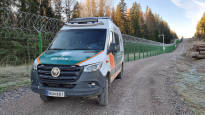Allowing asylum seekers to cross the border is still quite a small sting from the Russian authorities, ‘s Russia correspondent Heikki Heiskanen estimates.
Heikki Heiskanen ‘s Moscow correspondent
MOSCOW It has been reported in the Russian media about the border situation that the Finnish authorities are now blocking the entry of cyclists into Finland in addition to Russian passenger cars.
The news did not mention the reasoning of the Finnish border authorities that asylum seekers have recently arrived on bicycles, which the Russian border authorities – ultimately the security service FSB – have let pass without the documents required in Finland.
It’s easy to suspect that these are desperate people, because October-November doesn’t seem like the best time for cycling across any border.
According to the Finnish border authorities, the Russian authorities have therefore started to let people through from their side who do not have the documents required to enter Finland.
This shows how much the peace of the border relies on the quiet cooperation of the countries’ authorities. It may be that the Russians no longer feel the need to do the work of the Finnish border authorities.
From the point of view of the Russian authorities, Finland is no longer a friendly country. For them, Finland is a member of NATO, a military alliance hostile to Russia, which in part supports Ukraine with arms deliveries, i.e. the country against which Russia is waging a war of aggression.
In that situation, the way of thinking can prevail that even a small annoyance is a nuisance, especially when Finland has continuously made it difficult for Russians to cross the border.
Finland should therefore continue to be prepared for this type of trouble at the Russian border. It may be a way of expressing dissatisfaction with Finland’s line.
If it is really about Russia’s “hybrid influence”, it is clear that the Russian authorities have found a vulnerability that works from their point of view.
Now we are talking about 91 people since last August. You can’t really say that it’s a “current” or “avalanche” or “wave” as refugees are often described inhumanely. Still, this situation is top news in Finland.
In October–February 2015–2016, 1,756 asylum seekers arrived in Finland from Russia via the Raja-Joosepi and Salla border crossing points. The memory also has the situation of 2021, when thousands of people strive Alexander Lukashenko through autocratically ruled Belarus to Poland and Lithuania.
It is extremely easy and cost-effective to let even a relatively small number of asylum seekers through the Russian system, as this immediately arouses a very strong reaction in societies like Poland, the Baltic countries and Finland.
Even a relatively small number of refugees acts like a megaphone in the internal politics of these countries. It would be surprising if the Russian authorities had not already paid attention to this.
In addition, the actions of the authorities – border fences, barbed wire, riot squads – to prevent the arrival of asylum seekers give the authorities of Russia and Belarus yet another excellent opportunity to talk about hypocrisy and double standards: Why do these countries that preach democracy and human rights prevent the arrival of those in need?
The case also raises one small question about the EUR 380 million barrier being built on Finland’s eastern border.
At one time, many Finns also made fun of the recent US president Donald Trump’s for a large-scale border wall project. Our own border fence has not raised many doubts, because the construction of the fence was proposed by the trusted Finnish border authorities.
The question is this: Why would asylum seekers try to reach Finland through the difficult and unfamiliar forest terrain if the Russian authorities simply let them through at the official border crossing points?
A person seeking asylum then only needs to register with the border authority, and he is an asylum seeker in Finland.
